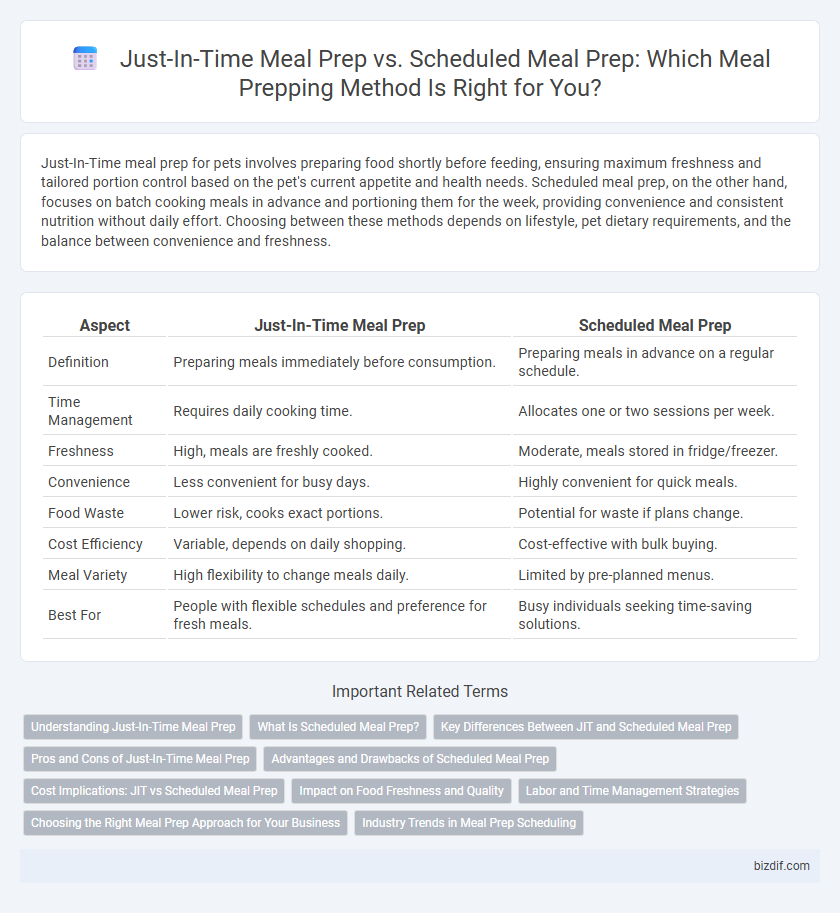Just-In-Time meal prep for pets involves preparing food shortly before feeding, ensuring maximum freshness and tailored portion control based on the pet's current appetite and health needs. Scheduled meal prep, on the other hand, focuses on batch cooking meals in advance and portioning them for the week, providing convenience and consistent nutrition without daily effort. Choosing between these methods depends on lifestyle, pet dietary requirements, and the balance between convenience and freshness.
Table of Comparison
| Aspect | Just-In-Time Meal Prep | Scheduled Meal Prep |
|---|---|---|
| Definition | Preparing meals immediately before consumption. | Preparing meals in advance on a regular schedule. |
| Time Management | Requires daily cooking time. | Allocates one or two sessions per week. |
| Freshness | High, meals are freshly cooked. | Moderate, meals stored in fridge/freezer. |
| Convenience | Less convenient for busy days. | Highly convenient for quick meals. |
| Food Waste | Lower risk, cooks exact portions. | Potential for waste if plans change. |
| Cost Efficiency | Variable, depends on daily shopping. | Cost-effective with bulk buying. |
| Meal Variety | High flexibility to change meals daily. | Limited by pre-planned menus. |
| Best For | People with flexible schedules and preference for fresh meals. | Busy individuals seeking time-saving solutions. |
Understanding Just-In-Time Meal Prep
Just-In-Time (JIT) Meal Prep involves preparing meals precisely when needed, minimizing waste and maximizing freshness by aligning cooking times closer to consumption. This method relies on efficient time management and quick ingredient access, ensuring flexibility and adaptability in daily meal routines. JIT Meal Prep is ideal for individuals seeking fresh meals without the bulk cooking typical of scheduled meal prep schedules.
What Is Scheduled Meal Prep?
Scheduled meal prep involves planning and preparing meals in advance based on a fixed timetable, often for the entire week. This method enhances time management by batch cooking ingredients or complete meals on specific days, reducing daily cooking stress. It supports dietary consistency and portion control, making it ideal for individuals with structured routines and specific nutritional goals.
Key Differences Between JIT and Scheduled Meal Prep
Just-In-Time (JIT) meal prep involves preparing food right before consumption, maximizing freshness and reducing waste, while Scheduled Meal Prep focuses on making meals in bulk at set times, enhancing time efficiency and portion control. JIT requires flexible planning and daily ingredient availability, whereas Scheduled Meal Prep relies on advanced planning and refrigeration or freezing for meal storage. The choice between JIT and Scheduled Meal Prep hinges on lifestyle preferences, with JIT suited for those valuing freshness and spontaneity, and Scheduled Meal Prep ideal for individuals seeking routine and convenience.
Pros and Cons of Just-In-Time Meal Prep
Just-In-Time Meal Prep allows for maximum freshness and flexibility by preparing meals only when needed, reducing food waste and adapting easily to changing schedules. However, it requires more time and energy daily, which may not suit busy individuals or those seeking convenience. This approach demands efficient planning and quick cooking skills to avoid last-minute stress and reliance on unhealthy alternatives.
Advantages and Drawbacks of Scheduled Meal Prep
Scheduled meal prep offers the advantage of saving time during busy weekdays by preparing meals in advance, ensuring consistent nutrition and portion control. However, it may lead to reduced meal variety and freshness, as pre-prepared dishes can lose flavor and texture over time. Additionally, strict schedules can limit flexibility, making it challenging to accommodate spontaneous plans or cravings.
Cost Implications: JIT vs Scheduled Meal Prep
Just-In-Time (JIT) meal prep reduces food waste and lowers grocery expenses by purchasing ingredients closer to consumption time, optimizing freshness and minimizing spoilage. Scheduled meal prep allows bulk buying and leveraging sales or discounts, which can decrease per-meal costs but risks higher wastage if plans change. Evaluating cost implications depends on balancing the precision of JIT purchasing against the economies of scale in scheduled bulk preparation.
Impact on Food Freshness and Quality
Just-In-Time Meal Prep enhances food freshness by preparing meals immediately before consumption, reducing the risk of nutrient degradation and loss of flavor. Scheduled Meal Prep allows bulk cooking but may compromise quality due to extended storage, leading to texture changes and potential nutrient loss. Selecting Just-In-Time or Scheduled Meal Prep significantly impacts meal taste, texture, and nutritional value, influencing overall dietary satisfaction.
Labor and Time Management Strategies
Just-In-Time Meal Prep minimizes food waste and maximizes freshness by preparing meals exactly when needed, demanding precise labor allocation and flexible time management to avoid last-minute stress. Scheduled Meal Prep streamlines kitchen workflow by allocating fixed periods for batch cooking, enhancing efficiency through routine and predictable labor assignments. Balancing these strategies depends on individual lifestyle, kitchen capacity, and daily time constraints to optimize productivity and meal quality.
Choosing the Right Meal Prep Approach for Your Business
Just-In-Time meal prep enables businesses to minimize food waste and optimize freshness by preparing meals only when orders are received, ideal for operations with highly variable demand. Scheduled meal prep focuses on producing meals in bulk at set times, improving efficiency and lowering labor costs in businesses with predictable sales patterns. Selecting the right approach hinges on analyzing order frequency, inventory capacity, and customer expectations to balance operational efficiency with food quality.
Industry Trends in Meal Prep Scheduling
Industry trends in meal prep scheduling reveal a growing preference for Just-In-Time meal prep due to its flexibility and reduction of food waste, aligning with sustainable consumption goals. Scheduled meal prep remains favored among busy professionals seeking structured nutrition and time management, supported by emerging apps integrating AI for personalized planning. Market data indicates a 30% annual growth in digital platforms offering hybrid models, combining the advantages of both prep styles to enhance user convenience and dietary adherence.
Just-In-Time Meal Prep vs Scheduled Meal Prep Infographic

 bizdif.com
bizdif.com